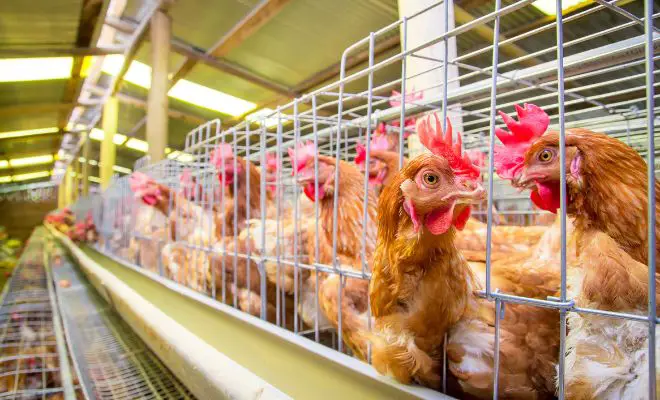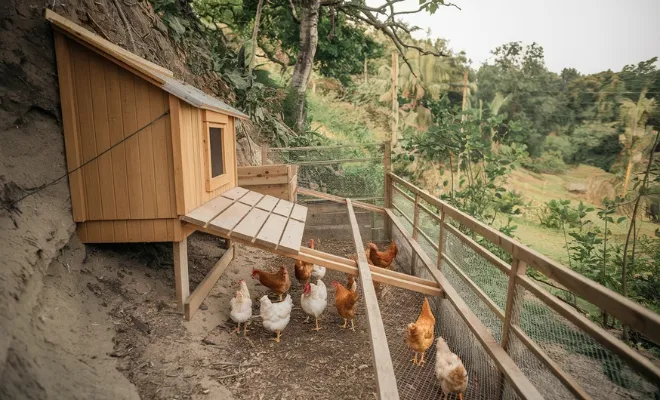Calculating Coop Size: How Many Chickens Thrive Per Square Foot?

If you are about to start farming or keeping chickens in your yard, coop space need is something that comes first! Chickens need ample space to thrive. But too many feathered friends in a coop can make pecking order fights and even illness!
So, how many chickens per coop is ideal? It depends! Ideally, you want enough space for chickens to move comfortably. A good rule of thumb is a 4 sq ft coop per chicken with free-range access. Also, you can keep 8 to 10 sq ft per chicken with limited outdoor access.
This post is your guide to figuring out the perfect coop size for your backyard flock. We’ll explore how chicken breeds, coop features, and even outdoor access all play a part.
Table of Contents
Understanding Chicken Space Requirements: Why Coop Size Matters?

Just like humans, chickens need enough space to live. But what could be the ideal chicken and coop size ratio? Why does coop size matter a lot?
Overcrowding in a coop can lead to stress. It makes your hens more susceptible to disease and less likely to lay eggs.
As I said, cramped quarters make it difficult for chickens to establish a pecking order. It leads to fighting and feather-pulling.
Good ventilation is crucial to prevent ammonia build-up and respiratory problems. A spacious coop allows for better air circulation. So, prioritize individual chickens!
Chickens are social creatures with a natural pecking order. A coop with enough square footage allows them to move around comfortably.
Also, provide ample space for nesting boxes (one for every 4-6 hens) and roosting perches (one foot per chicken).
Spacious outdoor runs can help chickens enjoy a smaller coop compared to those with limited outdoor access. In free-range situations, they get to expend energy and spread out during the day.
However, for chickens with minimal outdoor time, the coop becomes their primary space. So, you’ll need to provide more square footage per bird.
Note: Giant breeds like Brahmas need more room to roam compared to their pint-sized bantam cousins.
Factors to Consider When Determining Coop Size
Before welcoming chicken in your yard, know what to consider. It’ll help you make the perfect chicken coop based on flock number.
- Number of Chickens: The primary consideration is the number of chickens you intend to keep. Each chicken requires a certain amount of space for comfort and well-being.
- Breed Size: Different chicken breeds come in various sizes, ranging from bantams to large fowl. Larger breeds require more space compared to smaller ones.
- Behavioral Needs: Consider the behavior of your chickens. Some breeds are more active and may need extra space for roaming, while others are more docile and content with less space.
- Climate and Environment: The climate and environment where you live can also impact coop size. In colder climates, chickens may spend more time indoors, necessitating larger coops to prevent overcrowding.
- Roosting and Nesting Areas: Ensure there’s enough room for chickens to comfortably roost and lay eggs. Adequate nesting boxes and roosting bars are essential for their health and egg production.
- Future Expansion: Think about potential future growth in your flock. It’s wise to plan for expansion when designing your coop to avoid the need for frequent renovations or building additional structures.
Related Articles:
Do the Math: How to Calculate Coop Capacity for Chickens?

It’s crucial to ensure their coop is big enough for a comfortable and healthy life. So, how much coop space do your chickens actually need?
Square Footage Math
Here’s a handy rule of thumb to get you started –
- Free-range access: Keep 4 square feet per chicken
- Limited outdoor access: Allocate 8 square feet per chicken
Coop Capacity Calculation
Follow this simple formula to determine your ideal coop size:
Coop capacity (sq ft) = Number of chickens * Square footage per chicken
Example:
Let’s imagine you’re planning on raising 4 standard-sized chickens with free-range access. So, what is the chicken coop size for 4 chickens?
Coop capacity = 4 chickens * 4 sq ft/chicken = 16 sq ft
You can also get help from the following video. The video has suggestions about estimated ideas for chicken coop size based on flock number.
Additional Considerations
Chickens need dedicated roosting space for sleep. Allocate 1 foot of roosting space per chicken. You can provide enough nesting boxes for your hens. It should be one box for every 4-6 chickens.
Be sure you optimize your coop layout to maximize usable space.
If you want to know, how many broiler chickens are ideal per square foot? Or how many meat chickens per square foot? The answer is no difference! Both broilers and egg-layers use the same space guidelines.
What if you need space for egg-layer chickens? Same size for the egg layers, too!
Follow the given table to understand chicken numbers based on per coop.
| Chicken Type | Square Foot per Chicken (Free-Range Access) | Square Foot per Chicken (Limited Outdoor Access) | Notes |
|---|---|---|---|
| Standard Chicken Breeds | 4 sq ft | 8 sq ft | Breeds like Plymouth Rocks, Rhode Island Reds |
| Bantam Chicken Breeds | 2 sq ft | 4 sq ft | Breeds like Cochin Bantams, Serama Bantams |
| Standard Rooster | 8 sq ft | 10 sq ft | Only house 1 rooster per flock of hens |
| Bantam Rooster | 4 sq ft | 6 sq ft | Only house 1 rooster per flock of bantam hens |
FAQs
Check out this Q&A about coop size! They’ll help you figure out how many chickens your coop can hold.
Q. How many chickens can fit in an 8×10 coop?
With free-range access, an 8×10 coop (80 sq ft) could hold around 20 chickens. With limited outdoor time, it’s best to have no more than 10 chickens.
Q. What will be the best chicken coop size for 20 chickens?
For 20 chickens with free-range access, aim for a coop around 80 sq ft (minimum). If they have limited outdoor time, you’ll need a larger coop, closer to 160 sq ft.
Q. How big is a chicken coop for 1,000 chickens?
The indoor coop size would ideally fall between 3,000 sq ft and 5,000 sq ft. The outdoor run area is equally important so keep it 10,000 sq ft for the run.
Q. How much space do you need for 30 chickens?
With free-range access, 30 chickens would need a minimum of 120 sq ft. With limited outdoor space, you’d ideally want a coop closer to 240 sq ft.
Q. How many chickens are in a 10×10 run?
In a 10×10 run, you can comfortably accommodate 25 chickens.
Final Word
Making sure your chicken coop is just the right size is important for keeping your chickens healthy. Think about things like how big your chickens are, what they like to do, and the environment. If the coop is too crowded, it can stress out your chickens and make them sick. But if there’s plenty of space, they’ll get along better.
Whether your chickens get to run around outside or not, ensure the right coop size. So, take your time planning and building your home! Hope my guide helped you out!






